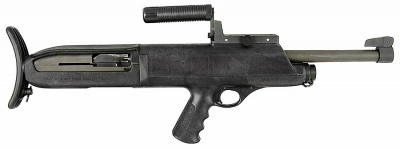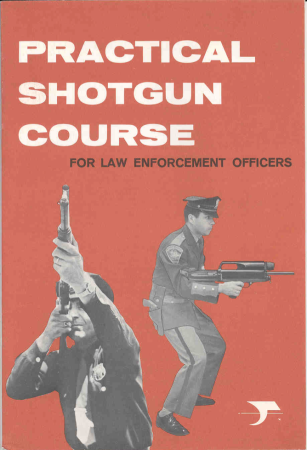


High Standard 10B (Video)
They were built around a regular High Standard semi automatic shotgun action, which was put into a plastic chassis to give it a bullpup configuration. They were chambered for 12 gauge, 2 3/4 inch shells, and required high-brass or other full-powered ammunition to run properly.
The idea of the bullpup layout really did have merit for the purposes High Standard intended, although the guns were not executed as well as they could have been.
In theory, the short overall length made the guns very handy for using in and around patrol cars, and the ability to effectively hold and fire the gun with only one hand would allow an officer to use his other hand for things like opening doors, moving obstacles, handling objects, etc.
The integrated flashlight (molded into the chassis on the 10A and detachable on the 10B) differs from today’s tactical weapons only in that traditional Mag-Lite type lights (specifically, the Kel-Lite) were used instead of today’s smaller and more powerful options.
The carry handle, folding front sight, flashlight mount, rotating buttplate, and very non-traditional appearance made for quite the eye-catching gun when these weapons hit the market.
Many police departments purchased them with the idea of modernizing, only to find them less practical in reality than in marketing, and they went out of production by the late 1970s.
For folks who are interested, here are a couple training documents published by High Standard on shotgun usage:


High Standard Model 10
| High Standard Model 10 | |
|---|---|

The High Standard Model 10B
|
|
| Type | Bullpup semi-automatic shotgun |
| Place of origin | United States |
| Service history | |
| Used by | See Users |
| Production history | |
| Designer | Alfred Crouch |
| Designed | Late 1950s |
| Produced | 1967–1977 |
| Variants | 10A, 10B |
| Specifications | |
| Weight | 4.54 kg (10 lbs) |
| Length | 660 mm (26 in) |
| Barrel length | 457 mm (18 in) |
|
|
|
| Cartridge | 12 gauge |
| Action | Gas-operated, semi-automatic |
| Effective firing range | ~40 m (~45 yards) |
| Feed system | 4+1 tube magazine, 6+1 with tube extension |
| Sights | Fixed; flip-up front, notched rear |
The High Standard Model 10 (HS10) is a gas operated, semi-automatic shotgun that was manufactured by the High Standard Manufacturing Company of Hamden, CT. It is easily recognized by its bullpup design, rotatable shoulder stock, and integrated flashlight.
Contents
[hide]
History and design[edit]
The basic design of the Model 10 shotgun was developed in the late 1950s by Alfred Crouch, a Santa Monica, California police sergeant. Crouch’s goal was to create the ultimate entry shotgun for SWAT and tactical units. His original design used a modified Remington semi-automatic shotgun.
In the mid 1960s, Crouch sold his design to the High Standard Manufacturing Company, who used their Flite King shotgun as the basis for the first model, the 10A. The Flite King was modified by replacing the stock, relocating the trigger assembly, and fitting a three-piece plastic shell around the receiver and first half of the barrel. The rearward piece of the shell provided an attachment point for the rotatable shoulder stock. The lower piece of the shell provided the grip. Since the trigger assembly was moved forward to accommodate the bullpup design, a rod that connected the new and original trigger locations was used to allow minimal modifications to the original Flite King receiver.
Although the standard capacity of the Model 10 is 4 shells, there was a magazine tube extension available which would increase the capacity to 6 shells.
On the early model shotgun the 10A, the upper plastic section also housed the built-in flashlight and carrying handle.
The later model shotgun the 10B was improved with a left-hand charging handle, flip-up front sight, and utilized the new flashlight mount/carrying handle mounting block (which doubles as the carrying handle mount) as the rear sight. The “Kel-Lite” branded flashlight can be removed, as it is attached to the aforementioned mounting block.
Service[edit]
Originally, the Model 10 was sold to law enforcement only. The concept of this shotgun was quite interesting to many police agencies who adopted the Model 10 in the late 1960s and early 1970s; however, most of the agencies found many shortcomings, and ultimately ceased using the Model 10.
The most common problem was the failure to cycle correctly. According to the instructions on the Model 10, only magnum or “high brass” shells were to be used. However, even with the correct shells, the action would sometimes fail to cycle reliably. Other problems that plagued the shotgun were the rough and unpredictable trigger feel, the strange rotatable shoulder stock, and the tendency of the recoil to cause the flashlight’s batteries to become damaged.
Another problem was that the Model 10 could only be fired from the right arm, as the gun ejected spent cartridges from the right side of the unit with a high force. There is a warning on the right side of the shotgun reading “CAUTION – DO NOT SHOOT FROM LEFT SHOULDER.”
Users[edit]
 Argentina Used by the Argentine Army and the Argentine Navy[citation needed]
Argentina Used by the Argentine Army and the Argentine Navy[citation needed] Mexico Used by the Mexican Army[citation needed]
Mexico Used by the Mexican Army[citation needed] United States Used by various U.S Police Forces
United States Used by various U.S Police Forces
